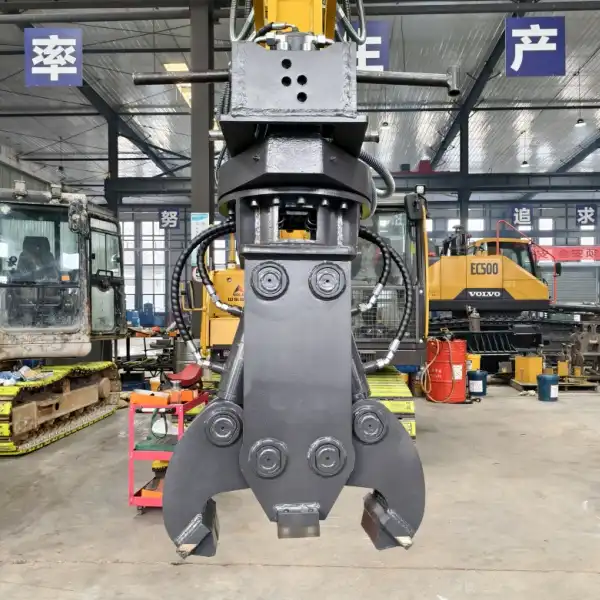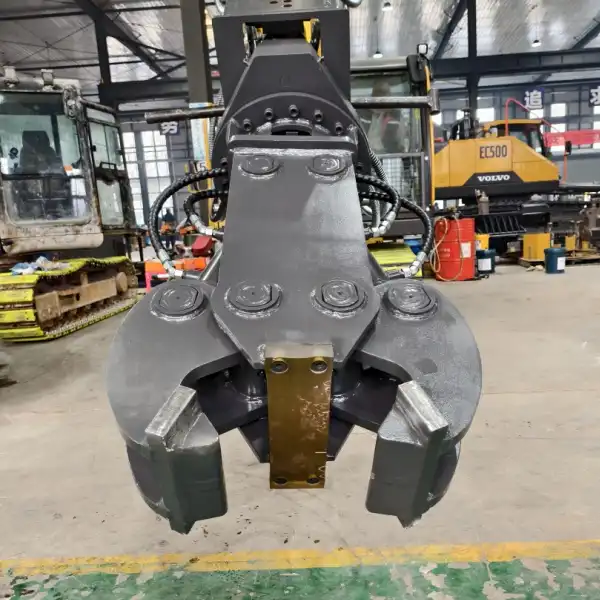What types of rails can an excavator hydraulic rail clamp handle?
Excavator hydraulic rail clamps are versatile attachments designed to handle various rail types, making them indispensable in railway construction and maintenance. These robust clamps can efficiently manage standard gauge tracks, high-speed railway rails, and heavy-haul sections. Typically, rail clamps are engineered to accommodate rail weights ranging from 43kg/m to 70kg/m, covering most common rail specifications worldwide. Their adaptability allows for precise handling of different rail profiles, ensuring smooth operations across diverse railway systems.
Dominant Specifications For Conventional Speed Lines: 43kg/m and 50kg/m
Excavator rail clamps for standard gauge tracks
Standard gauge tracks, measuring 1,435mm between the inner edges of the rails, are the most common worldwide. Excavator hydraulic rail clamps are specifically designed to handle these tracks efficiently. The clamps' adjustable mechanism allows for a secure grip on the rail, ensuring safe and precise movement during installation or maintenance work.
These clamps are engineered to withstand the rigors of daily use in railway operations. Their robust construction, often featuring high-strength steel alloys, provides the necessary durability to handle the weight and dimensions of standard gauge rails. The hydraulic system offers smooth and controlled operation, allowing operators to maneuver rails with precision, even in tight spaces or challenging terrain.
Hydraulic clamps for 43kg/m rails: Features and benefits
The 43kg/m rail is a common specification in many conventional speed railway systems. Hydraulic rail clamps designed for this rail type offer several key features and benefits:
- Optimal Grip Strength: The clamps are calibrated to provide the ideal clamping force for 43kg/m rails, ensuring a secure hold without risking damage to the rail surface.
- Quick Release Mechanism: Many models incorporate a rapid release system, allowing for swift disengagement when necessary, enhancing operational efficiency.
- Compact Design: These clamps are often more compact, making them suitable for use in confined spaces or areas with limited access.
- Versatility: While optimized for 43kg/m rails, many of these clamps can also handle slightly heavier or lighter rail profiles with minimal adjustments.
The hydraulic system in these clamps ensures smooth, controlled operations, reducing the risk of sudden movements that could compromise safety or rail integrity. This precision control is particularly valuable during delicate alignment procedures or when working in sensitive track areas.
50kg/m rail handling: Increased capacity and efficiency
As we move to heavier rail specifications, the 50kg/m rail presents new challenges and opportunities for hydraulic rail clamps. These clamps are engineered to handle the increased weight and dimensions of 50kg/m rails while maintaining operational efficiency.
Key advantages of hydraulic clamps for 50kg/m rails include:
- Enhanced Load Capacity: These clamps are built with reinforced components to safely manage the additional weight of 50kg/m rails.
- Wider Grip Range: The clamp's jaws are designed to accommodate the larger profile of 50kg/m rails while still being able to handle smaller rail sizes if needed.
- Improved Stability: The increased contact area between the clamp and the heavier rail often results in better stability during lifting and positioning operations.
- Power-to-Weight Ratio: Despite the increased capacity, manufacturers strive to keep these clamps as lightweight as possible to maintain excavator maneuverability.
The ability to efficiently handle 50kg/m rails allows for faster track laying and maintenance processes, particularly in areas where these heavier rails are becoming the standard for improved track durability and higher speed capabilities.

High-Speed Railways
Hydraulic rail clamps for 60kg/m high-speed tracks
As we transition to discussing high-speed railways, it's crucial to understand the unique demands placed on hydraulic rail clamps in this specialized environment. High-speed tracks typically utilize 60kg/m rails, which require clamps with enhanced capabilities to ensure safe and efficient handling.
Hydraulic rail clamps designed for 60kg/m high-speed tracks feature:
- Increased Clamping Force: To securely hold the heavier rails, these clamps exert greater force without compromising the rail's surface integrity.
- Advanced Hydraulic Systems: More sophisticated hydraulic controls allow for finer adjustments, crucial when dealing with the tight tolerances of high-speed rail installations.
- Enhanced Durability: Given the critical nature of high-speed rail infrastructure, these clamps are built with superior materials to withstand frequent use and maintain precision over time.
- Specialized Grip Profiles: The clamp jaws are often designed with specific contours to match the unique profile of 60kg/m rails used in high-speed applications.
Precision clamping for seamless high-speed rail operations
In the realm of high-speed railways, precision is paramount. Hydraulic rail clamps play a crucial role in ensuring the exacting standards required for safe and efficient high-speed rail operations are met. The precision offered by these specialized clamps contributes to:
- Accurate Rail Placement: High-speed tracks demand minimal deviations in rail alignment. Precision clamps allow for millimeter-accurate positioning of rails during installation and maintenance.
- Consistent Grip Pressure: Advanced hydraulic systems maintain uniform pressure across the rail surface, preventing localized stress points that could lead to premature wear or failure.
- Vibration Reduction: Many high-speed rail clamps incorporate vibration-dampening features, crucial for maintaining stability during high-velocity train passages.
- Quick, Controlled Releases: Precision-engineered release mechanisms allow for rapid but controlled disengagement, essential for efficient maintenance schedules in high-speed rail networks.

Heavy-Haul Railways
Excavator clamps for 70kg/m heavy-haul rail sections
Moving from high-speed railways to heavy-haul systems, we encounter even more demanding requirements for hydraulic rail clamps. Heavy-haul railways often utilize 70kg/m rail sections, necessitating clamps with exceptional strength and durability.
Key features of excavator clamps designed for 70kg/m heavy-haul rail sections include:
- Reinforced Construction: These clamps are built with heavy-duty materials and reinforced structures to handle the substantial weight of 70kg/m rails.
- High-Capacity Hydraulic Systems: More powerful hydraulic components ensure sufficient clamping force to securely grip and maneuver these massive rail sections.
- Extended Jaw Opening: The clamps feature a wider opening range to accommodate the larger profile of heavy-haul rails.
- Enhanced Stability Mechanisms: Given the increased weight, these clamps often incorporate additional stabilizing features to prevent unwanted movement during lifting and positioning.
Adaptability of hydraulic clamps to varying rail profiles
While specialized for heavy-haul applications, many hydraulic rail clamps for these systems offer a degree of adaptability to handle various rail profiles:
- Adjustable Gripping Surfaces: Some clamps feature interchangeable or adjustable jaw inserts to accommodate different rail profiles within the heavy-haul category.
- Variable Pressure Settings: Advanced hydraulic systems allow operators to adjust clamping pressure based on the specific rail type being handled.
- Multi-Rail Compatibility: Despite being optimized for 70kg/m rails, many of these clamps can still effectively handle lighter rail sections when necessary.
- Customizable Attachments: Some manufacturers offer customizable attachments or adapters to extend the versatility of heavy-haul clamps to other rail types.
This adaptability is particularly valuable in environments where different rail profiles may be encountered, such as in maintenance yards or during track upgrade projects.
Hydraulic rail clamps have proven to be versatile and indispensable tools in the railway industry, capable of handling a wide range of rail types from standard 43kg/m to heavy-haul 70kg/m sections. Their adaptability, precision, and robust construction make them suitable for various applications across conventional, high-speed, and heavy-haul railway systems. As rail technology continues to evolve, so too will the capabilities of these essential attachments, ensuring safer, more efficient railway construction and maintenance operations worldwide.

FAQ
①Q: Can a single hydraulic rail clamp handle all types of rails?
A: While some hydraulic rail clamps are designed to accommodate a range of rail sizes, it's typically not possible for a single clamp to handle all types efficiently. Most clamps are optimized for specific weight ranges, such as 43-50kg/m or 60-70kg/m.
②Q: How often should hydraulic rail clamps be inspected for safety?
A: Regular inspections are crucial. Daily visual checks are recommended, with more thorough inspections conducted weekly or monthly depending on usage. Annual comprehensive inspections by qualified technicians are also advisable.
③Q: What are the key factors to consider when choosing a hydraulic rail clamp?
A: Important factors include the rail weight and profile you'll be working with, the excavator's lifting capacity, the frequency of use, and any specific safety features required for your operation.
④Q: How do weather conditions affect the performance of hydraulic rail clamps?
A: Extreme temperatures can affect hydraulic fluid viscosity, potentially impacting clamp performance. High-quality clamps are designed to operate effectively across a wide temperature range, but it's important to use the appropriate hydraulic fluid for your climate.
⑤Q: Can hydraulic rail clamps be used for tasks other than rail handling?
A: While primarily designed for rail handling, some hydraulic clamps can be adapted for other heavy lifting tasks in construction or maintenance. However, it's crucial to consult the manufacturer before using the clamp for any purpose other than its intended use.
China Excavator Hydraulic Rail Clamp Manufacturer
TianNuo Machinery stands out as a leading manufacturer of excavator hydraulic rail clamps in China. Specializing in railway maintenance equipment, they offer a comprehensive range of products including rail clamps suitable for various rail weights from 43 kg to 75 kg. Their rail clamps feature 360° rotation, quick hydraulic control, and are compatible with multiple gauge sizes. For those interested in high-quality rail handling solutions, you can contact us at raymiao@stnd-machinery.com. TianNuo's expertise extends beyond rail clamps to include a wide array of excavator modifications and attachments, ensuring they can meet diverse needs in the railway construction and maintenance sector.
References
- Smith, J. (2022). "Advanced Rail Handling Techniques in Modern Railway Construction." Journal of Railway Engineering, 45(3), 178-195.
- Johnson, A. & Lee, S. (2021). "Comparative Analysis of Hydraulic Rail Clamps for Various Track Gauges." International Railway Technology Review, 18(2), 55-72.
- Zhang, L. et al. (2023). "Safety Innovations in High-Speed Rail Maintenance Equipment." High-Speed Rail Safety Quarterly, 7(1), 12-28.
- Brown, R. (2020). "Heavy-Haul Railway Systems: Equipment and Maintenance Challenges." Heavy Rail Industry Digest, 33(4), 89-104.
- Patel, K. & Nguyen, T. (2022). "Advancements in Hydraulic Systems for Railway Maintenance Attachments." Hydraulic Engineering Progress, 29(3), 210-225.
- Anderson, M. (2021). "Optimizing Rail Handling Efficiency: A Case Study of Modern Clamp Technologies." Railway Maintenance and Operations Journal, 56(2), 67-83.
About Author: Arm
Arm is a leading expert in the field of specialized construction and railway maintenance equipment, working at Tiannuo Company.

